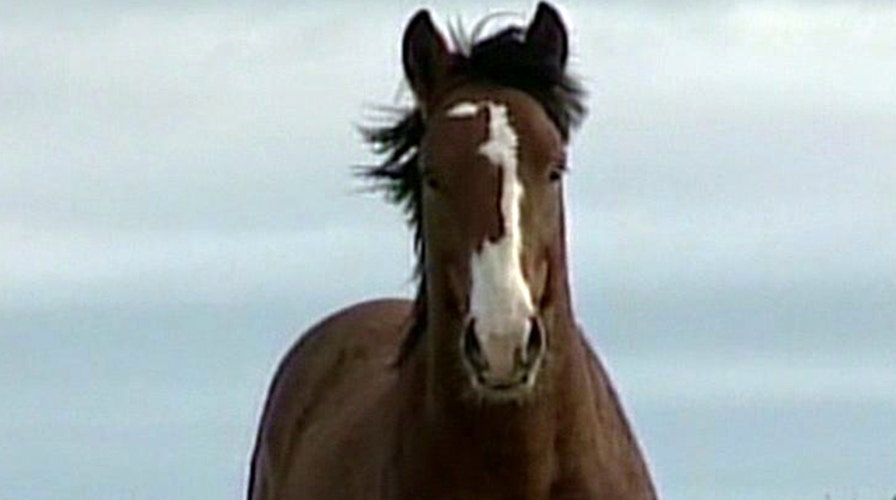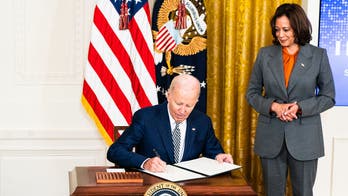There are 10,000 more horses and burros in the wild than their habitat can support, according to the Bureau of Land Management.
But, the agency says, there will soon be little they can do about it.
The overpopulation problem is now putting a big strain on the agency as it tries to figure out how to keep the spiraling population from harming the ecosystem.
The current conundrum can be traced in part to 1971. At the time, Congress passed the Free-Roaming Horses and Burros Act, which tasked BLM with preserving the wild animals in the 10 western states where they roamed. As with any grazing animal, though, the absence of predators caused the population to boom. After their numbers doubled in five years, Congress passed the Federal Land Policy and Management Act which made BLM responsible for keeping wild horse and burro populations in check.
Fran Ackley, who runs BLM's Wild Horse Program holding facility in Canon City, Colo., said that since there are no predators, federal officials "act as predators in that we remove horses (from the wild)." This, he said, "kind of serves as a similar act in controlling the population."
Rounded up animals are placed in long- and short-term holding facilities and put up for adoption. Adoptions, however, especially in the recent recession, have been far lower than the number of horses taken off the range. The result is that there are now some 50,000 "wild" horses and burros in BLM holding facilities around the West.
That's compared with roughly 37,000 currently in the wild, a number BLM says is 10,000 more than it should be. The agency says room in its holding facilities will reach capacity this year.
"The growth rate 'in the wild' is about 20 percent," Ackley explained. "So that means we're going to have another 7,400 horses this summer after foaling season. And right now it looks like we cannot remove all of them, maybe between 5,000 and 6,000 animals."
Each coming year, the population in the wild will increase, and if something isn't done, the BLM will be unable to remove any of them, according to Ackley. "If we don't manage them they're going to eat themselves out of house and home and destroy the habitat that supports -- not only them but, you know, endangered species, other plant and animal species and wildlife."
Currently the Wild Horse and Bureau Program spends about $50 million a year just to feed the animals held in captivity. That's around 70 percent of its annual budget, and horses in captivity live up to 25 years. When it comes to other grazing animals like deer, elk and bison, hunting acts as a substitute for natural predation.
Hunting horses, though, is prohibited.
And while horse meat is consumed by humans in much of the world, selling any of the horses to slaughter houses is a public relations nightmare the Bureau is determined to avoid.
"We'd like to see reproduction targeted as part of a solution," said Karen Herman, owner and operator of the Sky Mountain Wild Horse Sanctuary near Santa Fe, N.M. She said it's obvious to everyone the current system for managing wild horses is broken. "I think we need to be much more creative and innovative, and I think PZP is a science-based solution that's also ecologically and economically sound."
PZP, porcine zona pellucida, is a birth control drug that can last up to two years. Longer lasting fertility drugs are being developed. Herman has been involved in PZP trials in the Carson National Forest in northern New Mexico where mares are darted in the wild to inject the drug.
"It limits their reproduction so they can stay free, they can be wild." Herman said. "And yet their numbers aren't exceeding the capacity that the land can hold. There's 20 years of data that shows it's totally safe, it's 90 percent effective (and) it doesn't change their family behavior, their social behavior."
Many wild horse advocates oppose fertility control but Herman says the alternatives of roundup or overpopulation are far less attractive. "There's nothing humane about starvation -- it's a long, cruel, slow death. I respect other peoples' right to their perspective. Mine is that we have the means to help horses stay healthy and free. Why not use it?"
Ackley also feels that PZP is promising and points out that the BLM is also conducting trials. He agrees, though, that fertility control is only part of the solution.
"I'm going to guess there's in the neighborhood of 15 to 20 herds that we can actually do that: approach the horses on foot with a dart gun and put the drug into them. But you know, in Utah, Wyoming, California and Nevada, their horses are a lot more wild ... so that's really not practical in those populations."
Recently, Kathleen Mussetter came to the BLM Canon City holding facility to adopt one of the mustangs removed from the wild. "They're just so amazing. Just completely honest," she said.
Mussetter said she also worries about what will happen to the mustangs still roaming wild. "They reproduce out there, but the range is not reproducing. So I believe the BLM is kind of between a rock and a hard place. They're trying to do the right thing for the horses but what can you do? It's hard for a horse lover, it's a hard subject."





